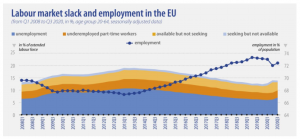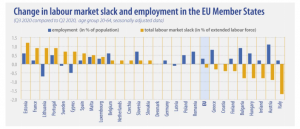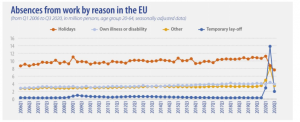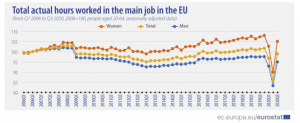The European Union labour market during the third quarter slack down to 13.9% as work hours increase due to the decision to relaxed COVID-19 measures. Eurostat noted that “Throughout the third quarter 2020, the labour market across the European Union (EU) recovered to some extent as COVID-19 measures taken were relaxed by most Member States. Persons who had been temporarily absent from work thus returned to work, and those who had been unable to search for a job or had been unavailable to take up a job returned to the labour force. This has contributed to an increase in both employment and unemployment, and to a slight decrease of the overall labour market slack.”
Additionally, the Eurostat published seasonally adjusted quarterly indicators which best illustrate the most recent movement on the labour market in the EU Member States, in addition to employment and unemployment. This adjustment comprises “total labour market slack, which comprises all persons who have an unmet need for employment, absences from work as well as an index of total actual hours worked in the main job. More new indicators on recent job leavers and starters, weekly total absences, as well as transitions are available in the Eurostat database.”
Employment up, labour market slack down
It was found that 29.4 million persons has unmet need for work which is consistent with the labour market gap decreasing slightly from 14.1% in the second quarter to 13.9% in the third quarter. Notably, in the third quarter of 2020, 188.0 million persons in the EU were employed. The EU seasonally adjusted employment rate for people aged 20-64 stood at 72.4%, up by 0.3 pp from 72.1% in the second quarter 2020. 14.8 million persons were unemployed and the EU seasonally adjusted unemployment rate was 7.3%, up from 6.7% in the second quarter 2020.

Labour market slack increased most in Estonia, employment increased most in Austria
During the third quarter, in the member of states the overall labour market slack increased 14 EU Member States compared to the second quarter, remained unchanged in 5 and decreased in 8 Member States. It was published that, “the highest increases were reported in Estonia (+1.2 pp), France, Lithuania and Portugal (all +0.9 pp), and the highest decreases in Italy (-1.7 pp), Austria (-0.9 pp), Ireland, Hungary and Bulgaria (all -0.8 pp). Employment rose in 18 countries, remained stable in 5 Member States, and fell in Lithuania (-0.7 pp), Cyprus (-0.5 pp), Latvia and Sweden (both -0.1 pp). The highest increases in employment were recorded in Austria (+1.1 pp), Bulgaria (+0.9 pp) and Greece (+0.8 pp).”

Number of employed persons temporarily absent from work returned to pre-COVID levels
In 2020 third quarter, the number of persons absent from work decreased from 18.0 million to 17.0 million when compared to the second quarter. Eurostat observed that “this return to pre-COVID levels is due to a sharp decrease in temporary lay-offs, while absences due to holidays dropped to a record low. At the same time, absences due to other reasons (i.e. absences not due to lay-off, holiday or illness), fell to pre-COVID levels between the two quarters.” Also, compared with the second quarter 2020, all Member States for which data are available experienced a drop in overall absences from work in the third quarter 2020. The largest drops were registered in Cyprus (-21.0 pp), Greece (-18.8 pp) and Slovakia (-18.6 pp). The highest rates of absences were observed in Sweden (16.1%), France (14.4%) and Austria (12.6%).

Total hours worked recovered in the third quarter 2020
Eurostat reported that, “the second and the third quarter 2020, total actual hours worked have recovered for women more than for men, increasing to 105 index points for women and to 95 index points for men. This is an increase of 16.0% over the quarter for women, and of 15.3% for men. Compared with the third quarter 2019, however, total actual hours worked dropped for both women and men, by 2.1% and 2.6% respectively. Compared with the third quarter 2019, however, total actual hours worked dropped for both women and men, by 2.1% and 2.6% respectively.” It was noted that, total actual hours worked recovered in the EU between the second quarter 2020 and the third quarter 2020, but have failed to return to pre-COVID levels. Notably, the levels of total actual hours worked are influenced by the total number of persons working, as well as the number of hours worked by each of these persons. Between

Disclaimer:
Analyst Certification -The views expressed in this research report accurately reflect the personal views of Mayberry Investments Limited Research Department about those issuer (s) or securities as at the date of this report. Each research analyst (s) also certify that no part of their compensation was, is, or will be, directly or indirectly, related to the specific recommendation(s) or view (s) expressed by that research analyst in this research report.
Company Disclosure -The information contained herein has been obtained from sources believed to be reliable, however its accuracy and completeness cannot be guaranteed. You are hereby notified that any disclosure, copying, distribution or taking any action in reliance on the contents of this information is strictly prohibited and may be unlawful. Mayberry may effect transactions or have positions in securities mentioned herein. In addition, employees of Mayberry may have positions and effect transactions in the securities mentioned herein.
